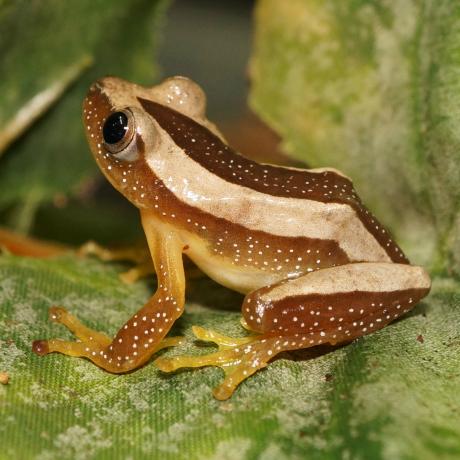

A small attractive species of frog, suited to keepers with some amphibian experience. Also known as the Four-Lined Spiny Reed Frog and Four-Lined Leaf Folding Frog.
| Origin | West to East Africa |
|---|---|
| Environment | Savanna and bushland |
| Adult Size | Up to 3cm |
| Suitability | Experienced keeper |
| Lifespan | Unknown |
Dark brown to orange dorsum with three regular light longitudinal stripes of equal width, confluent on the head. Adults are usually between 2.5-3cm with females being fractionally larger.
The range in which A. fulvovittatus are found in is enormous and covers most of West Africa, through the R. D. Congo and as far east as Kenya. It's likely that this complex contains more than one species.
A. fulvovittatus are more abundant in dry savanna in most of West Africa, but they can also be found in bushland and more humid savanna from Cameroon, eastward to the R. D. Congo and East Africa.
House in groups or singular in a glass terrarium of at least 18 x 18” (up to four specimens).
Temperatures should be maintained between 24-26°C (75-79°F) during the day, with a night-time temperature drop to 20°C (68°F). This can easily be achieved with a reflector dome, low wattage basking bulb and controlled by a dimming thermostat.
This species is nocturnal, so doesn’t strictly require any form of UVB lighting. However, the frogs may benefit from some form of low level UVB exposure. If you wish to provide this, ensure the bulb is amphibian friendly (not high level) and plenty of decor and plants are present, so not to cause stress. These lights can also help create a more natural day/night cycle within the terrarium.
Use a hand or pump sprayer and mist the enclosure every other day, but do not saturate the surroundings (remember this species is mostly found in dry savanna). Provide a good sized water bowl for bathing and remember to treat all tap water with a good quality dechlorinator. Aim to keep humidity levels around 70-75%.
Soil based substrates and moss are the best and most natural product to use on the habitat floor. For decor, we’d advise using leaning pieces of cork bark and branches for the frogs to climb on and over. Natural hides also provide a safe area for them to hide in or under during the day. Provide artificial plants tp provide additional cover, they can be maintained and mounted with ease. Alternatively, live planted bio-active setups work well, but remember this style of setup will require specialist LED lighting to maintain plant growth.
Live food of appropriate size should be offered to this species every other day. Crickets, locusts and curly-wing flies are readily taken. Remember to dust the live food in calcium supplement at least twice weekly and vitamin and mineral supplements just once a week.